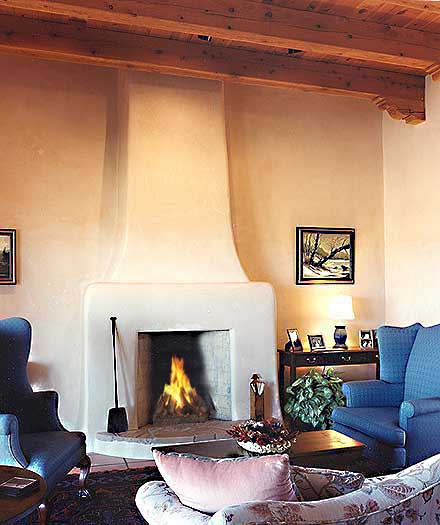The Little Fireplace That Could
By Peter Jensen* November, 1997
|
As another brutal San Diego winter descends on our homes and gardens, threatening sub-70 deg. temperatures and - what a surprise - the possibility of real El Nino-generated rain, it's time for my first good fire in the fireplace. What a favorite ritual it is! This year, however, I'm not satisfied to build a three-log eucalyptus fire and pull up the easy chair. I'm obsessed with the desire to build a "new" masonry fireplace based on an innovative design that is over two centuries old. The inventor was a brilliant Colonist named Benjamin Thompson, better known to history as Count Rumford, and for about half a century his design was so popular that most new American and British fireplaces were built to his specifications, or "Rumfordized" during remodeling. Thomas Jefferson had Rumfords at Monticello. Henry David Thoreau called them one of the "improvements of centuries" and a Rumford warmed his tiny cabin at Walden.
|
 This Rumford is in NM but it is "Spanish" in style.
|
|
Rumford was king of the flames until the Victorian-era popularity of airtight stoves (and central heating) made open fireplaces nothing more than an ambiance feature of the American house. In one of the more curious evolutionary sidetracks of house design, the classic Rumford plan was misinterpreted by other so-called fireplace experts. They preached that a fireplace had to have a "smoke shelf" hidden up behind the throat to help speed the smoke up the chimney instead of back out into the room. To this day, almost all masonry fireplaces are built with this unnecessary hidden shelf above and behind the damper. Rumfords send smoke up a very narrow, curved throat into a straight flue. They're very shallow; only about a foot deep if built properly. The fire is almost in the room, so they throw a ferocious amount of radiant heat directly at anyone standing or seated nearby. This unusual shallow design confuses people so much that even a visitor who can't be bothered with noticing the hand-cut joinery in your living room's woodwork will walk straight to a Rumford and exclaim, "What the hell is up with this fireplace? It's so shallow it must smoke like crazy. You don't burn wood in it, do you? Where's the gas jet?" And so forth. After first researching the Rumford design in an antiquarian book store's "colonial American architecture" section, I quickly sang its praises to friends, among them a couple in the midst of remodeling their 1920s California-Spanish house in San Diego. Against the wishes of their mason, they built a new Rumford. A puzzled building inspector forced them to deepen the firebox to 20 inches. Despite these impediments, the end result was a big, hand-built, handsome Rumford. Sadly, they never lit a first fire together, the one we all hold our breath on wondering if the new fireplace will smoke. A divorce interrupted the project. She lived on in the barely finished house, and despite being a fireplace enthusiast, her sorrow kept her from building a fire for at least a year. I began to dread receiving her telephone call. What if she finally lit a fire and the "Rumford" smoked? Oh the symbolism of all those up-in-smoke dreams! Meanwhile, I'd seen other Rumford designs in action. All doubts cease when you light a fire in a properly built Rumford. You watch them draw so demonically well that sheets of flame soar up their tall backs. Combustion is robust: Recent tests have proven that a good Rumford design can out-perform many wood-burning stoves and meet tightening EPA emissions standards.* Rumford is famous today (justifiably so) for his observations on the properties of heat. He was the first, for example, to recognize that radiant heat travels in straight lines and does not warm the "transparent air" that it passes through, but heats the body or non-reflective surfaces. Anyone who sits around a campfire on a cold night knows this to be true. His genius lay in his empirical observations of the everyday: He also applied his mind to the brewing of coffee, designed stoves and stew recipes for the starving masses of Germany, and solved many other pre-scientific-method conundrums. An expatriate, he was given the title of Count by a grateful Bavarian emperor. Eventually I did receive that winter's-day call from my friend. "Peter, I lit a fire," she said. I held my breath, waiting. "I can't believe it!" she shouted in the receiver, quite ecstatic about the whole experience. "It's wonderful! Incredible! It's already heated the room so well we had to open the patio doors!" Thanks, Count. ___________ *The only source of modern-day Rumford design and masonry fireplace components that meet these standards is the Buckley Rumford Company, Port Townsend, Washington; 360 385 9974, or http://www.rumford.com.
|

Buckley Rumford Fireplaces
Copyright 1995 - 2012 Jim Buckley
All rights reserved.
webmaster